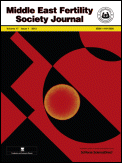
Middle East Fertility Society Journal
Scope & Guideline
Fostering collaboration in the pursuit of reproductive excellence.
Introduction
Aims and Scopes
- Reproductive Health Challenges in the Middle East:
The journal emphasizes research that addresses specific reproductive health challenges prevalent in the Middle East, including infertility, hormonal disorders, and the impact of lifestyle factors on reproductive outcomes. - Assisted Reproductive Technologies (ART):
A significant focus is placed on studies evaluating various ART methods, including IVF, ICSI, and embryo transfer techniques, aimed at improving clinical outcomes for patients undergoing these procedures. - Impact of Environmental and Lifestyle Factors:
Research exploring the influence of environmental exposures, lifestyle choices, and socio-economic factors on fertility and reproductive health is highlighted, reflecting a growing concern for public health. - Genetic and Molecular Insights:
The journal includes studies on genetic factors affecting fertility, such as polymorphisms and gene expression, providing insights into the molecular underpinnings of reproductive health issues. - Psychosocial Aspects of Infertility:
There is a focus on the psychological and social dimensions of infertility, including stigma, mental health, and the overall quality of life for individuals facing reproductive challenges.
Trending and Emerging
- Impact of COVID-19 on Reproductive Health:
Research exploring the effects of COVID-19 on fertility and reproductive health has surged, highlighting the pandemic's implications for both male and female reproductive systems and the psychosocial aspects of infertility during this period. - Polycystic Ovary Syndrome (PCOS) Research:
There has been a significant increase in studies focusing on PCOS, examining its hormonal, genetic, and metabolic implications, as well as innovative treatment options, reflecting its prevalence in the region. - Microbiome and Fertility:
Emerging research on the role of the microbiome in reproductive health has gained attention, with studies investigating how microbial communities in the reproductive tract influence fertility outcomes. - Nutritional and Lifestyle Interventions:
A growing body of work is focusing on the impact of nutrition, exercise, and lifestyle modifications on fertility, emphasizing preventative approaches and holistic treatment strategies. - Ethical and Societal Implications of ART:
As ART becomes more prevalent, there is an emerging trend towards examining the ethical, legal, and societal implications of these technologies, especially in the context of cultural attitudes in the Middle East.
Declining or Waning
- Traditional Fertility Treatments:
There is a noticeable decrease in research focused on traditional fertility treatments as newer technologies and methodologies gain traction, leading to a preference for studies on ART and innovative therapeutic approaches. - Single-Factor Studies:
The journal has seen fewer publications concentrating solely on single factors affecting fertility, with a stronger emphasis now on integrated and multifactorial approaches that consider a broader range of influences. - Historical Perspectives on Fertility:
Research examining historical or outdated practices related to fertility is becoming less common, as the focus shifts towards contemporary methods and evidence-based practices. - Generalized Fertility Education:
While educational research remains important, there is a decline in generalized studies on fertility education, with more emphasis now being placed on targeted interventions and specific population studies. - Animal Models in Fertility Research:
The frequency of studies utilizing animal models for fertility research has decreased, as there is a growing preference for clinical research that directly addresses human reproductive health.
Similar Journals

Frontiers in Reproductive Health
Empowering Voices in Reproductive Medicine.Frontiers in Reproductive Health is a leading open-access journal published by Frontiers Media SA in Switzerland, dedicated to advancing the field of reproductive health through high-quality research and comprehensive reviews. With a commitment to fostering an interdisciplinary dialogue, this journal covers an array of topics including epidemiology, family practice, obstetrics and gynecology, and reproductive medicine. As of 2023, it ranks in the Q3 quartile in Epidemiology, Q1 in Family Practice, and Q2 in both Obstetrics and Gynecology and Reproductive Medicine, reflecting its significance and growing influence in these areas. Researchers and professionals can benefit from the journal's wide distribution and open access policy, which facilitates the sharing of knowledge and enhances the visibility of their work. By embracing innovative studies and harnessing the talents of both established scholars and emerging voices, Frontiers in Reproductive Health plays a crucial role in shaping the future of reproductive health research and practice.

Reproductive Biology and Endocrinology
Connecting Researchers in Reproductive Biology and EndocrinologyReproductive Biology and Endocrinology, published by BMC, is a distinguished open-access journal established in 2003, catering to researchers and professionals in the interdisciplinary fields of reproductive biology, endocrinology, and related biomedical sciences. With a notable impact in 2023, the journal has achieved Q1 rankings in Obstetrics and Gynecology, Reproductive Medicine, and Endocrinology, alongside a Q2 ranking in Developmental Biology, establishing itself as a pivotal source of high-quality research and insights. The journal's commitment to freely accessible research promotes knowledge dissemination across its domains, which is crucial for advancing understanding of reproductive health and endocrine mechanisms. With a robust Scopus ranking showcasing its relevance—17th out of 209 in Obstetrics and Gynecology, and 8th out of 90 in Reproductive Medicine—it serves as an essential resource for academics and clinicians alike, facilitating innovative research and fostering collaboration within the global scientific community.
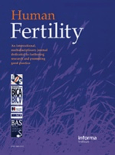
Human Fertility
Elevating Standards in Human Fertility StudiesHuman Fertility, published by Taylor & Francis Ltd, is a key academic journal that serves the dynamic fields of medicine, obstetrics and gynecology, and reproductive medicine. Established in 1998 and with converged content extending to 2024, the journal holds a notable Q2 ranking in its respective categories, highlighting its influence and scholarly contributions to current research and practice. With an ISSN of 1464-7273 and an E-ISSN of 1742-8149, it rigorously disseminates studies, reviews, and advancements in human fertility, particularly emphasizing evidence-based practices and innovative techniques. Despite its traditional subscription model, the journal remains vital for researchers, healthcare professionals, and students seeking to foster advancements in reproductive health. Its articles are pivotal in addressing the multifaceted challenges faced in reproductive health and guiding future research trajectories.

Reproduction and Fertility
Elevating the discourse in reproductive sciences.Reproduction and Fertility is a premier academic journal published by BIOSCIENTIFICA LTD, dedicated to advancing knowledge in the fields of reproductive sciences, obstetrics, gynecology, and related areas. Established with a focus on delivering high-quality research, this journal has quickly ascended in prominence, achieving a commendable Q2 ranking in multiple categories, including Embryology, Obstetrics and Gynecology, Reproductive Medicine, and Urology, as of 2023. With an E-ISSN of 2633-8386, Reproduction and Fertility aims to provide a valuable platform for researchers, professionals, and students alike, offering insights into the latest discoveries and innovations in reproductive health. Although currently not an open-access journal, it remains committed to disseminating important findings that can influence clinical practices and policy-making worldwide. Operating from its headquarters in Bristol, United Kingdom, the journal serves as an essential resource for anyone invested in understanding and improving reproductive health outcomes through rigorous academic research.
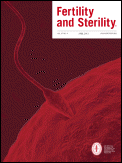
FERTILITY AND STERILITY
Transforming understanding of fertility issues.Fertility and Sterility is a prestigious peer-reviewed journal dedicated to the fields of obstetrics, gynecology, and reproductive medicine. Published by Elsevier Science Inc, this journal has been a cornerstone of scientific discourse since its inception in 1950 and is set to continue its influential coverage of cutting-edge research until 2024. Boasting an impressive impact factor, Fertility and Sterility is ranked among the top-tier journals in its category, holding Q1 status in both Obstetrics and Gynecology and Reproductive Medicine. With Scopus rankings placing it in the 97th and 96th percentiles respectively, the publication serves as a vital resource for researchers, clinicians, and students who seek to advance their understanding of fertility issues and reproductive health. Although it does not currently offer open access options, the journal remains committed to disseminating high-quality research and innovative solutions to the complex challenges in reproduction, empowering professionals and scholars to make meaningful contributions in their fields.
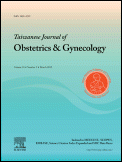
Taiwanese Journal of Obstetrics & Gynecology
Cultivating a Community of Excellence in Women's Health ResearchTaiwanese Journal of Obstetrics & Gynecology, published by Elsevier Taiwan, stands as a leading platform in the field of obstetrics and gynecology, fostering academic discourse and innovative research since its inception in 2004. With an impact factor that places it in the Q2 category of its field, it ranks #84 out of 209 journals in Obstetrics and Gynecology according to Scopus, indicating a significant reputation within the medical community. This open access journal ensures wide dissemination of research findings, allowing professionals, researchers, and students alike to stay updated with the latest advancements and practices. The journal's focus on publishing high-quality, peer-reviewed articles covers a broad range of topics within the field, making it an essential resource for those interested in women's health issues, clinical practices, and medical advancements in Taiwan and beyond. With its commitment to excellence, the Taiwanese Journal of Obstetrics & Gynecology invites contributions that enhance the understanding and management of obstetric and gynecological care.

Gynakologische Endokrinologie
Elevating Clinical Practices in Endocrinology and GynecologyGynakologische Endokrinologie is a pivotal journal published by SPRINGER HEIDELBERG, dedicated to advancing the fields of endocrinology, obstetrics, gynecology, reproductive medicine, and pediatrics. With an ISSN of 1610-2894, this journal serves as a valuable platform for researchers and practitioners to disseminate their findings and explore emerging trends and treatments in the realm of women's health and endocrine disorders. Though currently positioned in the Q4 quartile across relevant categories, its mission is to foster scholarly discourse that bridges gaps in knowledge and enhances clinical practices. With a commitment to quality research, it provides a forum for innovative studies and case reports that could influence future healthcare strategies. Positioned in Germany, Gynakologische Endokrinologie aims to cater to a global audience, enhancing knowledge and collaboration in critical areas impacting women's health and hormone-related conditions.

Reproductive Sciences
Empowering Professionals with Cutting-Edge FindingsReproductive Sciences is a premier journal published by SPRINGER HEIDELBERG, dedicated to the field of obstetrics and gynecology. With its ISSN 1933-7191 and E-ISSN 1933-7205, the journal has established itself as a leading source of high-quality research and clinical insights since its inception in 2007, and continues to converge its scope into 2024. Currently ranked in the Q1 category for obstetrics and gynecology, it holds the 43rd position among 209 journals in the Scopus rankings, underscoring its influence and relevance within the medical community. This journal is particularly dedicated to advancing knowledge in reproductive health, providing a platform for innovative research and clinical practices through both traditional and open access options. Located in Switzerland with an address in Heidelberg, Germany, Reproductive Sciences is not just a publication; it is a vital resource for researchers, professionals, and students seeking to make impactful contributions to the field of reproductive health.
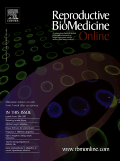
REPRODUCTIVE BIOMEDICINE ONLINE
Elevating knowledge in developmental biology and reproductive health.Reproductive Biomedicine Online, published by Elsevier, is a leading peer-reviewed journal that has established itself as a pivotal resource in the fields of Developmental Biology, Obstetrics and Gynecology, and Reproductive Medicine. With an impressive Impact Factor and a Q1 ranking in its respective disciplines as of 2023, this journal provides a platform for innovative research and comprehensive reviews that contribute to advancements in reproductive healthcare. The journal boasts rigorous Scopus rankings, placing it within the top tiers of its categories, which underscores its significance in shaping contemporary biomedical inquiry. Although not open access, it remains widely accessible through institutional subscriptions, making its wealth of knowledge available to researchers, clinicians, and students alike. Since its inception in 2000, Reproductive Biomedicine Online has been committed to fostering a deeper understanding of reproductive processes and biomedicine, ensuring that its content remains relevant and impactful in addressing challenges in reproductive health, thereby championing exceptional scientific discourse.

Human Reproduction Open
Elevating standards in reproductive medicine and health.Human Reproduction Open, published by Oxford University Press, is a prestigious open-access journal dedicated to advancing the field of reproductive health and medicine since its inception in 2017. With an E-ISSN of 2399-3529, the journal provides a vital platform for researchers, clinicians, and academics to disseminate innovative findings in obstetrics, gynecology, and reproductive medicine. It is recognized for its impactful contributions, holding an impressive rank of #3 out of 209 in Medicine - Obstetrics and Gynecology, #2 out of 90 in Medicine - Reproductive Medicine, and #1 out of 21 in Medicine - Embryology, placing it in the top percentiles of its respective categories. The open-access model ensures that research is freely accessible, fostering collaboration and knowledge sharing among professionals and students alike. With a commitment to high-quality, peer-reviewed publications, Human Reproduction Open plays a crucial role in shaping the future of reproductive health research and practice, serving as an essential resource for those dedicated to improving outcomes in this dynamic field.